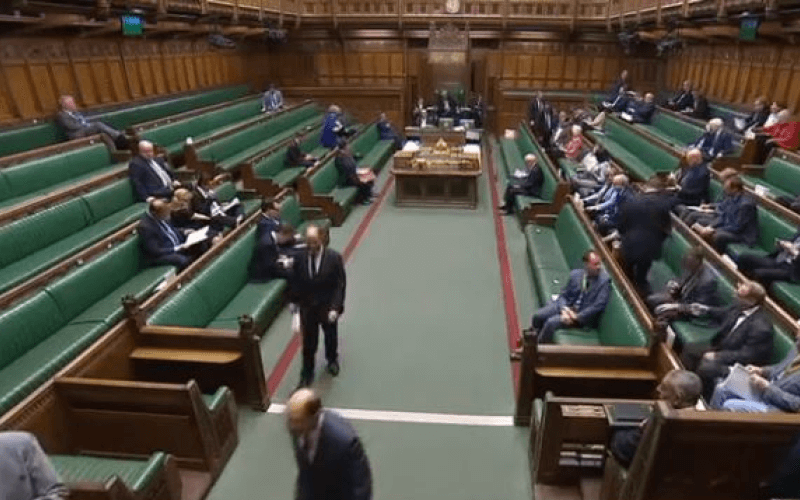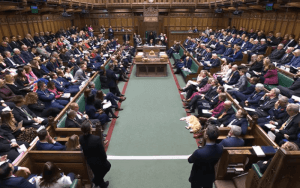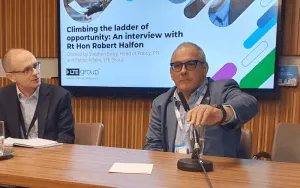New designs for a temporary House of Commons chamber will allow wheelchair-users who become ministers or shadow ministers to address fellow MPs from behind the historic despatch boxes for the first time.
Disability News Service (DNS) has been told that the plans for the temporary chamber – to be used while major renovations are carried out to the Palace of Westminster – include “tip-up seating” that will enable wheelchair-users to speak from behind the two respective despatch boxes.
The current cramped design of the Commons chamber (pictured) means there is no room for a wheelchair in front of the benches used by government and shadow ministers.
There is also no space for a wheelchair to pass behind the despatch boxes when ministers and shadow ministers are in their places.
But the new plans – which are now out for public consultation – would allow, for the first time, a minister or even a prime minister who uses a wheelchair to address fellow MPs from the traditional position behind the despatch box.
The long-delayed plans to renovate the Houses of Parliament will see MPs and peers move out and work in separate buildings nearby in Westminster – probably soon after 2025 – while a major programme of repairs and improvements takes place over a number of years.
Peers are expected to move into the Queen Elizabeth II Conference Centre, but MPs and Commons staff will be relocated to a group of parliamentary buildings known as the Northern Estate, which includes Portcullis House.
The plans include building a temporary House of Commons chamber – modelled to look similar, although not identical, to the current chamber – as part of a redevelopment of Richmond House, formerly the Whitehall headquarters of the Department of Health.
Dame Anne Begg, the last wheelchair-user to be elected as an MP, welcomed the plans to allow wheelchair-users to sit alongside colleagues on the front benches for the first time.
She said: “Absolutely. That’s the one you were never able to do before.
“I was never a frontbencher but that’s the next stage forward. Someone in a wheelchair being able to sit and be a frontbencher, potentially in the cabinet, potentially a prime minister, I think is a wonderful step forward.
“I am glad that they are thinking about it.”
Dame Anne, who lost her seat in 2015 after 18 years as a backbench Labour MP – including several years chairing the influential work and pensions select committee – had to position herself in the corner of the chamber, near the entrance, throughout her time in parliament.
She said: “I am glad they are thinking there might be more than one person in a wheelchair in the chamber and that the person in the wheelchair might need to sit in different parts of the chamber, depending on their role and whether they were a backbencher or a frontbencher.
“None of those adaptions were made in my time but that’s because I didn’t push for them, because I was the first person in a wheelchair to be sitting in the chamber since 1880.
“I thought disabled people had been invisible too long, so I was quite happy to stick out.
“It was a conscious decision that I wanted to be seen rather than be invisible as we had been for generations.”
DNS has also been told that the space between the two sets of front benches will be wider, allowing a wheelchair-user to pass between the despatch boxes and ministers or shadow ministers.
The project’s design team is still working on the arrangements that will be made for wheelchair-users on the backbenches.
A spokesperson for parliament’s relocation programme said: “The design team are developing solutions to make sure MPs who use wheelchairs can sit with their party colleagues, and for those locations to not just be along the front benches.
“These changes in the temporary Chamber will support the future design work of both of the historic Chambers in the Palace [of Westminster], where improvements to disabled access will be a key feature.”
The proposals for the temporary chamber will also include hearing loops and infra-red audio systems for d/Deaf MPs and visitors, although the spokesperson said: “In the chamber, rather than assume a single solution will work for everyone, parliament will continue to support the individual needs of members who require support.”
The design of the temporary chamber will also ensure access if there is a speaker, deputy speaker or clerk with a mobility impairment.
The current plans will see every seat on the front row of the public gallery feature tip-up seating for wheelchair-users, while there will be two lifts for visitors to access the public gallery, accessible toilets off the central lobby area and the public gallery lobby space, and a Changing Places toilet off the central lobby.
Doors will be fitted with electronic assistance opening devices “where required”.
The parliamentary authorities are working on the designs of the temporary chamber with David Bonnett Associates (DBA), the award-winning architectural access consultancy run by disabled architect David Bonnett, as well as the Centre for Accessible Environments (CAE).
Both DBA and CAE said they were not yet allowed to comment on their work on the project.
There have also been discussions with parliament’s own access and inclusion steering group, with wider engagement with disabled people to take place later in the design process.
Commons authorities are now keen to hear from disabled people about the plans and the publicly accessible facilities they would like to see included around the temporary chamber.
There will be a public exhibition of the plans in nearby Church House on 30 May, 1 June, 7 June, 8 June and 10 June.
A series of planning applications are likely to be submitted to Westminster council later this year, which should allow work to begin on the Northern Estate next year.
A note from the editor:
Please consider making a voluntary financial contribution to support the work of DNS and allow it to continue producing independent, carefully-researched news stories that focus on the lives and rights of disabled people and their user-led organisations.
Please do not contribute if you cannot afford to do so, and please note that DNS is not a charity. It is run and owned by disabled journalist John Pring and has been from its launch in April 2009.
Thank you for anything you can do to support the work of DNS…

 Majority of disabled MPs voted against assisted suicide bill, figures show
Majority of disabled MPs voted against assisted suicide bill, figures show Former minister calls for access improvements to ‘appalling’ House of Commons facilities
Former minister calls for access improvements to ‘appalling’ House of Commons facilities Commons confirms MPs received DWP ‘violence’ book, as Reeves warns of ‘difficult’ decisions on ‘welfare’
Commons confirms MPs received DWP ‘violence’ book, as Reeves warns of ‘difficult’ decisions on ‘welfare’